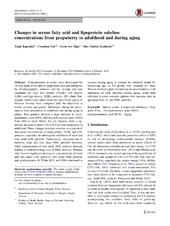Changes in serum fatty acid and lipoprotein subclass concentrations from prepuberty to adulthood and during aging
Peer reviewed, Journal article
Published version

Åpne
Permanent lenke
https://hdl.handle.net/1956/15735Utgivelsesdato
2016-03Metadata
Vis full innførselSamlinger
- Department of Chemistry [433]
Originalversjon
https://doi.org/10.1007/s11306-016-0968-ySammendrag
Concentrations in serum were determined for 18 fatty acids (FAs) and 21 lipoprotein main and subclasses by chromatographic analyses and the average size was calculated for very low density (VLDL), low density (LDL) and high density (HDL) particles. 283 ethnic Norwegian children and adults from the rural Fjord region of Western Norway were compared with the objectives to reveal patterns and gender differences during the development from prepuberty to adulthood and during aging in adults. Both genders showed a large increase in eicosapentaenoic acid (EPA) and docosahexaenoic acid (DHA) from child to adult. Males, but not females, show a significant increase in most C16–C18 FAs from prepuberty to adulthood. These changes in males correlate to a pattern of increased concentrations of triglycerides, VLDL and LDL particles, especially the atherogenic subclasses of small and very small LDL particles. Furthermore, concentrations of medium, large and very large HDL particles decrease, while concentration of very small HDL particles increase leading to reduced average size of HDL particles. Females only showed significant increase in concentrations of small and very small LDL particles, very small HDL particles and apolipoprotein B. While EPA and DHA continued to increase during aging in women, no validated model for connecting age to FA profile was obtained for men. Women showed significant increase in concentrations of all subclasses of LDL particles during aging, while men exhibited a more complex pattern with increase also in apolipoprotein A1 and HDL particles.
